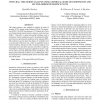Free Online Productivity Tools
i2Speak
i2Symbol
i2OCR
iTex2Img
iWeb2Print
iWeb2Shot
i2Type
iPdf2Split
iPdf2Merge
i2Bopomofo
i2Arabic
i2Style
i2Image
i2PDF
iLatex2Rtf
Sci2ools
ICASSP
2009
IEEE
2009
IEEE
Postural time-series analysis using Empirical Mode Decomposition and second-order difference plots
This paper presents a new method for analysis of center of pressure (COP) signals using Empirical Mode Decomposition (EMD). The EMD decomposes a COP signal into a finite set of band-limited signals termed as intrinsic mode functions (IMFs). Thereafter, a signal processing technique used in continuous chaotic modeling is used to investigate the difference between experimental conditions on the summed IMFs. This method is used to detect the degree of variability from a second-order difference plot, which is quantified using a Central Tendency Measure (CTM). Seventeen subjects were tested under eyes open (EO) and eyes closed (EC) conditions, with different vibration frequencies applied for the EC condition in order to provide additional sensory perturbation. This study has demonstrated an effective way to differentiate vibration frequencies by combining EMD and second-order difference (SOD) plots.
ICASSP 2009 | Second-order Difference | Second-order Difference Plot | Signal Processing | Vibration Frequencies |
| Added | 21 May 2010 |
| Updated | 21 May 2010 |
| Type | Conference |
| Year | 2009 |
| Where | ICASSP |
| Authors | Ram Bilas Pachori, David J. Hewson, Hichem Snoussi, Jacques Duchêne |
Comments (0)

